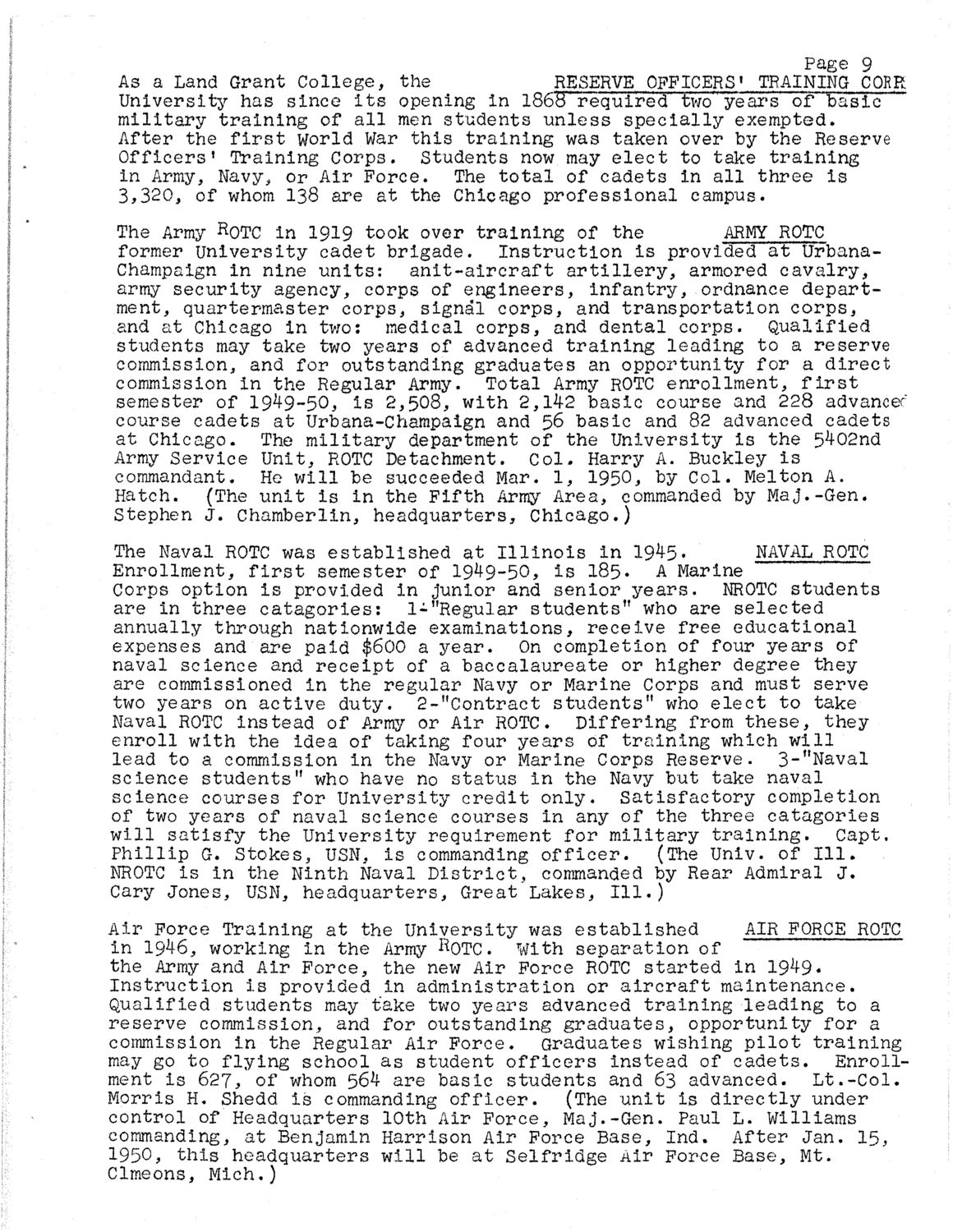| |
| |
Caption: Reference Folder - 1949
This is a reduced-resolution page image for fast online browsing.

EXTRACTED TEXT FROM PAGE:
pap*e 9 As a Land Grant College, the RESERVE OFFICERS' TRAINING CORR University has since its opening in 1868 required two years of basic military training of all men students unless specially exempted. After the first World War this training was taken over by the Reserve Officers' Training Corps, Students now may elect to take training in Army, Navy, or Air Force. The total of cadets in all three is 3*320, of whom 138 are at the Chicago professional campus. The Army ROTC in 1919 took over training of the ARMY ROTC former University cadet brigade* Instruction is provided at UrbanaChampaign in nine units: anit-aircraft artillery, armored cavalry, army security agency, corps of engineers, infantry, ordnance department, quartermaster corps, signal corps, and transportation corps, and at Chicago in two: medical corps, and dental corps. Qualified students may take two years of advanced training leading to a reserve commission, and for outstanding graduates an opportunity for a direct commission in the Regular Army. Total Army ROTC enrollment, first semester of 1949-50, Is 2,508, with 2,142 basic course and 228 advancer course cadets at Urbana-Champaign and 56 basic and 82 advanced cadets at Chicago. The military department of the University is the 5402nd Army Service Unit, ROTC Detachment. Col. Harry A- Buckley is commandant. He will be succeeded Mar. 1, 1950, by Col. Melton A. Hatch. (The unit is in the Fifth Army Area, commanded by-MaJ.-Gen. Stephen J. Chamberlin, headquarters, Chicago.) The Naval ROTC was established at Illinois in 1945 • NAVAL ROTC Enrollment, first semester of 1949-50, is 185* A Marine Corps option is provided in junior and senior years. NROTC students are in three catagories: 1-"Regular students" who are selected annually through nationwide examinations, receive free educational expenses and are paid $600 a year. On completion of four years of naval science and receipt of a baccalaureate or higher degree they are commissioned in the regular Navy or Marine Corps and must serve two years on active duty. 2~,fContract students" who elect to take Naval ROTC instead of Army or Air ROTC. Differing from these, they enroll with the idea of taking four years of training which will lead to a commission in the Navy or Marine Corps Reserve. 3~f,Naval science students" who have no status in the Navy but take naval science courses for University credit only. Satisfactory completion of two years of naval science courses in any of the three catagories will satisfy the University requirement for military training. Capt. Phillip G. Stokes, USN, is commanding officer. (The Univ. of 111. NROTC is in the Ninth Naval District, commanded by Rear Admiral J. Cary Jones, USN, headquarters, Great Lakes, 111.) Air Force Training at the University was established AIR FORCE ROTC in 1946, working in the Army R 0TC. With separation of the Army and Air Force, the new Air Force ROTC started in 1949* Instruction is provided in administration or aircraft maintenance. Qualified students may take two years advanced training leading to a reserve commission, and for outstanding graduates, opportunity for a commission in the Regular Air Force. Graduates wishing pilot training may go to flying school as student officers instead of cadets. Enrollment is 627, of whom 564 are basic students and 63 advanced. Lt.-Col. Morris H. Shedd is commanding officer. (The unit is directly under control of Headquarters 10th Air Force, Maj.-Gen. Paul L. Williams commanding, at Benjamin Harrison Air Force Base, Ind. After Jan. 15, 1950, this headquarters will be at Selfridge Air Force Base, Mt. Clmeons, Mich.)
| |